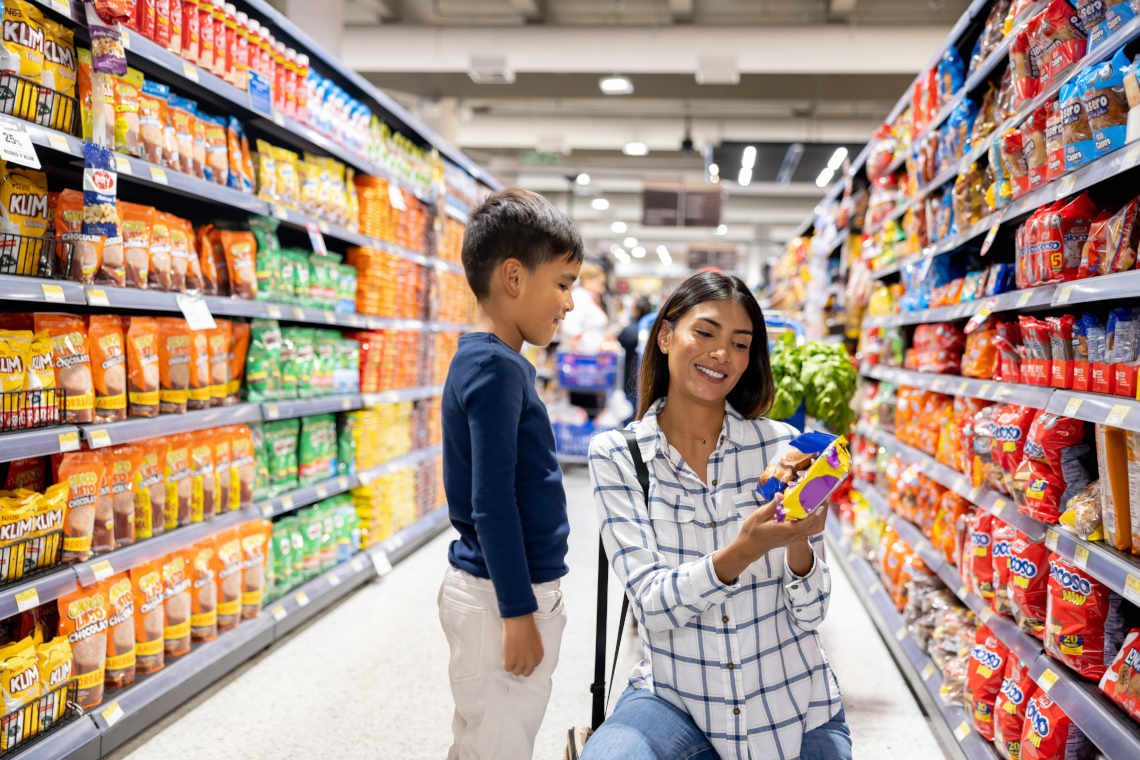Food Packaging market research offers the roadmap, unraveling insights into emerging trends, innovative materials, and consumer behavior patterns. As consumers demand transparency, convenience, and eco-friendly solutions, comprehensive food packaging market research becomes instrumental in guiding packaging innovations, navigating regulatory landscapes, and meeting evolving consumer expectations.
Such research empowers food businesses to adapt, innovate, and thrive in a dynamic and competitive marketplace by providing insights into market trends, material advancements, and consumer preferences.
Food packaging market research explores the details of product presentation, storage, and protection. It aims to understand consumer perceptions and preferences regarding packaging to study how these aspects influence their purchasing decisions.
The research encompasses several factors such as material analysis, design elements, functionality, sustainability, and regulatory compliance. It offers a comprehensive overview of the current state of the market, providing stakeholders with essential information to navigate the intricate landscape of food packaging.
The primary aim of food packaging is to sustain food quality and safety, extend shelf life, and offer convenience to customers. Moreover, food packaging can also increase brand recognition, present nutritional information, and encourage sustainability. By evaluating the latest trends, such as the move to more sustainable packaging and the increasing significance of e-commerce, companies can tailor their packaging solutions to remain competitive and successful.
Consequently, conducting market research into food packaging is a key component of success for businesses within the food industry. This research enables them to identify consumer needs and preferences, assess the success of their current packaging, and create new strategies to meet changing demands.
- Consumer Perception and Brand Image: Through thorough food packaging market research, brands can gain insights into how their packaging is perceived by consumers and customize it to resonate better with their target audiences.
- Safety and Compliance: It becomes imperative to ensure that the packaging can withstand diverse conditions without compromising product safety. Moreover, a thorough understanding and adherence to regional packaging regulations are key in preventing potential legal complications.
- Sustainability and Environmental Impact: Since consumers display heightened environmental awareness, they actively seek out brands that resonate with their values, particularly when it comes to packaging practices. Thus, by conducting comprehensive food packaging market research, businesses can accurately assess the demand for sustainable packaging solutions.
- Innovation and Differentiation: In crowded marketplaces, how can a brand distinguish itself from the competition? The answer lies in innovation and differentiation. Through market research, businesses can discover gaps in the market and uncover opportunities for unique packaging solutions that will set them apart.
- Economic Considerations: Understanding which materials and designs appeal to consumers can yield cost-effective outcomes. It is essential to strike the right balance between over-packaging and under-packaging to obtain a cost-effective packaging process.
Food packaging market research is essential for information on the most relevant market segments, trends, and drivers. Through market research, businesses can discover the most efficient packaging materials and designs that match the target market and evaluate their competitors’ packaging strategies.
This type of research also provides invaluable insights into consumer behavior, preferences, and buying patterns, which can aid businesses in developing effective packaging strategies. By focusing on their target customers’ needs and wants, businesses can create packaging that meets their functional requirements and appeals to them visually. This can help foster brand recognition and customer loyalty, which are crucial for sustained success in the food industry.
Some of the critical benefits of food packaging market research include:
- Increased Sales and Market Share: Effective packaging can boost product sales. When packaging aligns with consumer values and stands out on the shelf, it exerts a significant influence on purchasing decisions.
- Competitors Assessment: Assessing competitors’ packaging tactics to gain an in-depth insight into the market competitive landscape and develop packaging solutions that differentiate from them.
- Customer Engagement and Loyalty: Packaging that resonates with consumers has the power to enhance brand engagement. For example, if consumers prioritize sustainability and a brand’s packaging reflects this value, it can foster stronger brand loyalty.
- Reducing waste and improving efficiency: Businesses can enhance sustainability and cost-effectiveness by researching to identify the most optimal packaging solutions. This approach enables them to minimize both material waste and expenses.
- Optimized Shelf Presence: In retail environments, the packaging plays a crucial role as it silently represents the brand and helps drive sales. Well-designed packaging has the power to capture consumers’ attention, while research provides valuable insights on which design elements and messaging have the greatest impact on store shelves.
- Exploring Future Trends: Food packaging market research goes beyond the present and delves into the future. By gaining insights into upcoming market directions, brands have the opportunity to become pioneers by embracing prospective packaging trends ahead of their competitors.
- Enhancing Brand Image and Perception: By employing well-researched insights, brands can strategically develop their packaging to create a distinctive image. This image may align with various desired perceptions such as luxury, eco-friendliness, affordability, etc.
Manufacturers of food packaging materials and products are primary users of this research. They rely on insights gained to innovate and improve their offerings, ensuring that their products are functional and align with the latest trends in sustainability and consumer preferences. By understanding the market’s direction, these manufacturers can develop packaging solutions that appeal to food producers and end consumers, enhancing their market position.
Similarly, food producers and retailers utilize food packaging market research to make informed decisions about the packaging of their products. This research helps them to understand which packaging materials and designs resonate with their target audience, ultimately influencing purchase decisions. For instance, an increasing consumer preference for eco-friendly packaging pushes companies to adopt biodegradable or recyclable materials. Additionally, insights into the effectiveness of packaging designs in communicating brand values and product benefits are crucial for marketing strategies, affecting how products are perceived on the shelves.
Regulatory bodies and environmental organizations also benefit from food packaging market research. Such entities use the data to monitor industry trends and ensure compliance with safety, labeling, and environmental impact regulations. Understanding the market allows them to anticipate changes and adjust policies accordingly, promoting public health and environmental sustainability.
The food packaging market is characterized by its dynamic nature and the presence of numerous key players, ranging from multinational corporations to innovative startups. Understanding these main players’ identities provides insights into the competitive landscape and potential partnership or benchmarking opportunities.
- Tetra Pak is a leading provider of processing and packaging solutions for food and beverages. The company is at the forefront of innovative packaging designs that enhance functionality, extend shelf life, and reduce environmental impact.
- Ball Corporation specializes in aluminum packaging for beverages, personal care, and household products, but its innovations also extend to the food sector. The company’s aluminum cans and bottles are highly recyclable, offering sustainable packaging that appeals to environmentally conscious consumers.
- Berry Global Group offers a comprehensive portfolio of plastic packaging products, including containers, bottles, and closures for the food and beverage industry. Berry Global emphasizes innovation and sustainability, aiming to improve product protection while minimizing environmental impact.
The SIS International Research approach to food packaging market research embodies a comprehensive and strategic methodology that equips businesses with the insights and intelligence to navigate the complex food packaging landscape effectively. This approach is characterized by a meticulous blend of quantitative and qualitative research techniques, advanced analytics, and deep industry expertise.
- Tailored Research Design: At the core of the SIS approach is the development of a customized research design that aligns with each client’s specific objectives and challenges. This bespoke strategy ensures that the research covers broad market trends and delves into the nuances critical for the client’s unique position and goals.
- Integration of Advanced Analytics: SIS transforms raw data into actionable insights using state-of-the-art analytics tools and techniques. This includes the application of predictive analytics to forecast market trends, sentiment analysis to gauge consumer perceptions, and competitive intelligence frameworks to evaluate the strategic positioning of key players.
- Expert Stakeholder Engagement: Recognizing the value of diverse perspectives, the SIS approach incorporates extensive engagement with industry stakeholders, including manufacturers, retailers, consumers, and regulatory bodies. Through in-depth interviews, focus groups, and surveys, SIS captures various viewpoints, ensuring the research findings are comprehensive and multifaceted.
- Emphasis on Sustainability and Innovation: In line with the growing importance of sustainability and innovation in the food packaging industry, SIS significantly emphasizes these areas within its research. By exploring sustainable packaging trends, materials, and practices and investigating the latest innovations in packaging technologies and designs, SIS provides clients with guidance on how to align their strategies with environmental considerations and consumer expectations for innovation.
- Actionable Recommendations: The culmination of the SIS research process is the delivery of strategic recommendations that are practical, actionable, and tailored to the client’s specific context. These recommendations inform product development, marketing strategies, sustainability initiatives, and overall business strategy, enabling clients to achieve competitive advantage and market leadership.
Conducting food packaging market research is not a one-time activity but a continuous process that supports businesses in adapting to market trends, regulatory changes, and consumer behaviors. Several key factors signal the need for food packaging market research.
- Regulatory Compliance: The food packaging industry is subject to stringent regulations that vary significantly across regions and countries. Conducting market research helps businesses ensure that their packaging meets all legal requirements, including those related to material safety, labeling, and environmental impact. Staying informed about regulatory changes through market research is essential for maintaining compliance and avoiding potential legal issues.
- Sustainability Initiatives: Food packaging market research is key in identifying sustainable materials and practices that reduce environmental impact. This research supports businesses in making informed decisions about adopting eco-friendly packaging options, which can enhance brand image, meet consumer demand for sustainability, and comply with environmental regulations.
- Product Launch and Innovation: Market research provides critical insights into the feasibility, consumer acceptance, and competitive positioning for businesses introducing new products or exploring innovative packaging solutions. Understanding the market landscape helps identify opportunities for differentiation and ensure that new packaging designs align with consumer preferences and industry trends.
Food packaging market research has uncovered various factors that drive changes and innovation within this industry. Understanding these drivers is crucial for businesses to maintain their competitiveness and adaptability.
- Sustainability and the Environment: Consumers’ growing environmental concerns have fueled a rising preference for eco-friendly packaging solutions, such as biodegradable materials or containers designed for reusability.
- Minimalistic Design: Packaging design that emphasizes simplicity has been proven effective in conveying transparency and honesty, two qualities highly valued by modern consumers.
- Portion Control and Single-serve Packages: As more people embrace fast-paced lifestyles, there is a growing demand for conveniently packaged single-serving portions. This trend reflects the increasing preference of health-conscious consumers who seek portion control options.
- Health and Safety Concerns: Health and safety concerns have been heightened due to the COVID-19 pandemic. There is a growing emphasis on packaging that ensures the integrity and safety of food products.
- Value-added Packaging: Value-added packaging is gaining popularity among consumers seeking convenience. These packages go beyond containment by offering features like resealability or built-in utensils.
- Cultural and Local Relevance: In an increasingly globalized world, consumers are looking for authentic experiences. Packaging that connects with local cultures or tells a captivating story about its origin holds strong appeal for many individuals.
- Updated data: Packaging is integral to brand recognition and advertising strategies. Thus, food packaging market research provides valuable data concerning the most effective packaging designs and materials for various product categories.
Navigating the complexities of the food packaging market demands attention to several critical success factors that can shape the outcomes of businesses operating within this dynamic landscape:
- Regulatory Compliance: Adherence to stringent regulatory standards is paramount in the food packaging industry to ensure consumer safety and maintain legal compliance. To avoid costly penalties and reputational damage, businesses must stay abreast of evolving regulations related to food contact materials, labeling requirements, and environmental sustainability.
- Innovative Design and Materials: Innovation in packaging design and materials is essential for success in the food packaging market. Businesses that invest in research and development to create functional, sustainable, and aesthetically appealing packaging solutions can differentiate themselves from competitors and meet the evolving needs of consumers and food manufacturers.
- Sustainability and Environmental Responsibility: With increasing consumer awareness and regulatory pressure on environmental sustainability, businesses must prioritize sustainability in their packaging practices. Utilizing recyclable, compostable, and biodegradable materials, reducing packaging waste, and implementing eco-friendly production processes can enhance brand reputation and meet consumer demand for environmentally responsible packaging solutions.
- Supply Chain Collaboration: Collaboration across the food packaging supply chain is critical for success, as businesses must work closely with suppliers, manufacturers, retailers, and regulatory authorities to ensure seamless operations and product quality. Building strong relationships, fostering transparency, and implementing effective communication channels can streamline processes, mitigate risks, and drive innovation throughout the supply chain.
- Consumer Preferences and Market Trends: Understanding consumer preferences, trends, and emerging technologies is essential for staying competitive in the food packaging market. Businesses that conduct market research to identify shifting consumer behaviors, preferences for convenience, sustainability, and health-consciousness can tailor their packaging solutions to meet evolving market demands and capitalize on emerging opportunities.
Within the food packaging market, several segments emerge as leaders in driving growth and innovation, catering to diverse consumer needs and industry trends:
- Flexible Packaging: Flexible packaging, including pouches, wraps, and bags, is a leading segment in the food packaging market due to its versatility, convenience, and sustainability. Flexible packaging offers benefits such as lightweight, space-saving design, extended shelf life, and enhanced product visibility, making it ideal for a wide range of food products, including snacks, beverages, and ready-to-eat meals.
- Rigid Packaging: Rigid packaging offers durability, protection, and tamper resistance, ensuring product integrity and safety during transportation and storage. With advancements in materials and manufacturing technologies, rigid packaging continues to evolve to meet changing consumer preferences and industry requirements.
- Paperboard Packaging: Paperboard packaging offers branding opportunities, product differentiation, and eco-friendly credentials, making it appealing to environmentally conscious consumers and food manufacturers. With growing demand for sustainable packaging solutions, paperboard packaging continues to gain traction as a leading segment in the food packaging market.
- Biodegradable and Compostable Packaging: Biodegradable and compostable packaging offer benefits such as reduced environmental impact, renewable resources, and compatibility with organic waste disposal systems. As sustainability becomes a key focus for consumers and regulators, biodegradable and compostable packaging are expected to see continued growth and adoption in the food packaging market.
- Smart Packaging: Smart packaging, incorporating technologies such as RFID tags, sensors, and QR codes, revolutionizes the food packaging market by enabling enhanced functionality, traceability, and communication. Smart packaging offers benefits such as real-time monitoring of product freshness, temperature control, and interactive engagement with consumers, enhancing product safety, transparency, and brand loyalty.
The food packaging market is globally distributed, with significant shares across various regions driven by factors such as population size, economic development, and consumer preferences:
- North America: North America holds a substantial share of the food packaging market, driven by a large population, a robust food industry, and strong consumer demand for convenient and sustainable packaging solutions. The United States, in particular, boasts a highly developed food packaging sector, with advanced technologies, stringent regulatory standards, and a focus on innovation driving market growth.
- Europe: Europe is another significant player in the food packaging market, characterized by a mature food industry, stringent regulatory requirements, and a strong emphasis on sustainability. Countries such as Germany, France, and the United Kingdom are key contributors to the European food packaging market, focusing on eco-friendly packaging materials, active and intelligent packaging solutions, and premium packaging designs catering to diverse consumer preferences.
- Asia-Pacific: The Asia-Pacific region is experiencing rapid growth in the food packaging market, fueled by population growth, urbanization, and rising disposable incomes. Countries such as China, India, Japan, and South Korea are driving market expansion, with increasing demand for packaged foods, ready-to-eat meals, and convenience-oriented packaging formats.
In the realm of food packaging market research, several key target audiences emerge, each playing a crucial role in driving innovation, adoption, and investment in the industry:
- Food Manufacturers: Food manufacturers represent a primary target audience for food packaging market research, as they rely on packaging solutions to preserve product freshness, enhance shelf life, and meet consumer expectations. From large-scale food processors to small artisanal producers, food manufacturers leverage market insights to inform packaging design, material selection, and technology adoption, ensuring their products remain competitive in the marketplace.
- Packaging Suppliers: Packaging suppliers, including manufacturers of packaging materials, equipment, and technologies, are key stakeholders in the food packaging ecosystem. These suppliers utilize market research to understand industry trends, consumer preferences, and regulatory requirements, enabling them to develop innovative packaging solutions that meet the evolving needs of food manufacturers.
- Retailers and Distributors: Retailers and distributors play a critical role in the food packaging market, serving as the final touchpoint between packaged foods and consumers. Retailers leverage market research to understand consumer preferences, packaging trends, and purchasing behavior, guiding their product selection, merchandising strategies, and marketing initiatives.
- Regulatory Authorities: Regulatory authorities, including government agencies and industry associations, play a vital role in shaping the food packaging market through the development and enforcement of regulations, standards, and guidelines. These authorities rely on market research to assess industry trends, evaluate emerging technologies, and address regulatory gaps related to food safety, labeling, and packaging materials.
Embarking on food packaging market research yields many strategic benefits, equipping businesses with the insights to navigate market complexities and capitalize on opportunities – and here are some outcomes that businesses can expect from comprehensive market research.
- In-depth Industry Insights: Businesses can expect to gain a thorough understanding of market size, growth trends, and future forecasts, allowing for informed strategic planning. This includes insights into consumer behaviors, preferences, and shifting demands, especially regarding sustainability and convenience.
- Innovation and Product Development Guidance: One of the primary outcomes of food packaging market research is identifying innovation opportunities. This encompasses advancements in materials, technologies, and designs that can set a product apart in the crowded market space. Research findings can guide product development teams in exploring new packaging solutions that address unmet consumer needs or enhance the user experience, fostering innovation that resonates with target audiences.
- Competitive Advantage: A well-executed market research strategy offers comprehensive insights into competitive landscapes, including the strategies and offerings of key players. This knowledge enables businesses to identify their unique value proposition and differentiate their products.
- Risk Mitigation: Food packaging market research provides an early warning system for emerging trends, regulatory shifts, and potential challenges that could impact business operations. By anticipating changes and adapting strategies accordingly, businesses can mitigate risks and navigate market uncertainties more confidently.
- Strategic Market Entry and Expansion: Food packaging market research offers critical insights into market feasibility, consumer demographics, and entry barriers for businesses looking to enter new markets or expand their presence. This information is vital for developing market entry or expansion strategies grounded in reality, maximizing the chances of success in new ventures or territories.
The evolving landscape of food packaging presents several opportunities for businesses. Therefore, leveraging the insights from food packaging market research can provide a competitive edge and open new avenues for growth and innovation. Here’s a look at some opportunities available:
- Collaborations and Partnerships: Collaborating with tech firms or startups can expedite the integration process of smart packaging solutions. Such partnerships can offer technological expertise and fresh perspectives.
- Direct Consumer Feedback: With the rise of social media and instant feedback mechanisms, businesses can engage directly with consumers to understand their packaging preferences. This engagement can foster loyalty and provide real-time insights, enhancing food packaging market research findings.
- Customized and Regional Packaging: Recognizing regional tastes and cultural nuances can lead to packaging tailored to specific demographics, enhancing consumer engagement and driving sales in targeted markets.
- Focus on Health and Wellness: The ongoing emphasis on health means businesses can design packaging promoting wellness. This could be through packaging that retains nutritional value, is BPA-free, or offers portion control.
- Augmented Reality (AR) in Packaging: Integrating AR into packaging can provide consumers with a richer experience, offering them interactive recipes, nutritional insights, or the story behind the product.
- Niche Market Exploration: With food packaging market research, businesses can identify niche markets or underserved segments, offering unique packaging solutions catering to those specific needs.
Navigating the food packaging industry presents many challenges for businesses, from adapting to rapidly changing consumer preferences to meeting stringent regulatory requirements. Here, we explore some key hurdles businesses face in food packaging market research.
- Sustainability Pressures: As environmental awareness increases, companies are under growing pressure to adopt sustainable packaging solutions. This involves selecting recyclable materials and designing packaging that minimizes waste throughout the supply chain.
- Regulatory Compliance: The food packaging is heavily regulated to ensure consumer safety and environmental protection. Navigating the complex landscape of global regulations requires constant vigilance and adaptability. Ensuring compliance while maintaining operational efficiency and market competitiveness is a continuous challenge for companies.
- Cost Management: Packaging materials and production costs can significantly affect a company’s bottom line. Fluctuations in raw materials prices such as paper, plastic, and metals, can impact profitability. Companies must find ways to manage these costs effectively while still meeting quality and sustainability standards.
- Supply Chain Complexity: The globalization of the food industry has led to increasingly complex supply chains. Ensuring the timely delivery of packaging materials and managing logistics efficiently are critical for maintaining production schedules and meeting market demand. Disruptions in the supply chain, whether due to geopolitical issues, natural disasters, or other factors, pose a significant risk to businesses.
Porter’s Five Forces framework provides valuable insights into the competitive dynamics of the food packaging industry, helping businesses assess the attractiveness of entering or expanding within the market:
- Threat of New Entrants: The threat of new entrants to the food packaging industry is relatively moderate. While the industry is characterized by high barriers to entry such as capital investment, regulatory compliance, and access to distribution channels, the emergence of innovative startups and disruptive technologies poses a potential threat to established players.
- Bargaining Power of Buyers: The bargaining power of buyers in the food packaging industry is significant, driven by factors such as the abundance of packaging options, low switching costs, and the importance of packaging in product differentiation. Food manufacturers have the power to negotiate prices, terms, and packaging specifications with packaging suppliers, leveraging their purchasing volume and market influence to secure favorable deals.
- Bargaining Power of Suppliers: The bargaining power of suppliers in the food packaging industry varies depending on factors such as material availability, technological capabilities, and supplier concentration. While suppliers of raw materials such as plastics, paper, and metals wield some power due to their control over essential inputs, the presence of multiple suppliers and alternative materials mitigates their bargaining power to some extent.
- Threat of Substitutes: The threat of substitutes in the food packaging industry is relatively low, as packaging plays a crucial role in preserving food freshness, safety, and convenience. While alternative packaging formats such as reusable containers, bulk packaging, and unpackaged products exist, they often lack the functionality, protection, and branding opportunities traditional packaging solutions offer.
- Intensity of Competitive Rivalry: The intensity of competitive rivalry in the food packaging industry is high, driven by price competition, product differentiation, and technological innovation. Established players compete fiercely for market share, leveraging their brand reputation, manufacturing capabilities, and R&D investments to gain a competitive edge.
SIS International offers comprehensive solutions designed to address the challenges and leverage the opportunities in the food packaging market. Through tailored market research and strategic consulting services, SIS empowers businesses to make informed decisions, drive innovation, and achieve sustainable growth:
- Market Insights: SIS International conducts in-depth market research to provide businesses with valuable insights into consumer preferences, market trends, competitive dynamics, and regulatory landscapes in the food packaging industry. By understanding market nuances and identifying emerging opportunities, businesses can develop targeted strategies to capitalize on market trends and gain a competitive edge.
- Strategic Planning: SIS International’s strategic consulting services assist businesses in formulating actionable plans and strategies to navigate market challenges and capitalize on growth opportunities in the food packaging industry. Whether entering new market segments, optimizing product portfolios, or enhancing sustainability initiatives, we collaborate with clients to align their business objectives with market realities and drive strategic decision-making.
- Competitive Analysis: SIS International conducts a thorough competitive analysis to help businesses understand their competitive landscape, identify key competitors, and uncover areas for differentiation in the food packaging market. Businesses can refine their value proposition and position themselves effectively in the market by benchmarking performance, analyzing strengths and weaknesses, and identifying emerging threats.
- Customized Solutions: SIS International offers customized solutions tailored to each client’s unique needs and objectives in the food packaging industry. Whether conducting primary research, analyzing data, or providing strategic recommendations, our team collaborates closely with clients to deliver actionable insights and support their packaging initiatives.
- Measurable Impact: SIS International’s research methodologies enable businesses to measure their food packaging initiatives’ impact and return on investment. By tracking key performance indicators, evaluating strategies’ effectiveness, and identifying improvement areas, businesses can demonstrate tangible results to stakeholders and drive continuous improvement in their packaging practices.
Project Summary
Industry: Food Packaging
Timeline: 8 weeks
Methodologies:
- Targeted extensive primary data collection by interviewing industry experts, providing a more in-depth understanding of the drivers in the paperboard industry.
- Verification of findings achieving a higher level of confidence by triangulating findings from multiple sources.
- Interviewed end-use product segments: Cookies/Crackers/Snacks, Confectionary, Frozen foods, Dry foods, Dairy/Ice-cream/Frozen Novelty, QSR Takeout and Household Goods.
Scope of the Research
SIS International Research (“SIS”) sought to understand the factors that influence packaging/paperboard material decisions for major FMCG food brands. SIS conducted in-depth interviews with companies operating throughout the pipeline of converters and distributors of this material, including the biggest suppliers of paperboard substrates in the industry. In addition, extensive desk research is conducted to develop a robust understanding of the trends, drivers, constraints and statistics within the US food packaging industry. Research is done utilizing online media, web, peer reviewed journals, industry news and company reports, where appropriate.
This research focused on marketing, operations, quality, packaging development and procurement decision factors in seven folding carton end-use product segments.
Key Intelligent Topics and Objectives
Competitive and Market intelligence:
Analyze competitors to gain insights in the decision making process for their paperboard substrate choice.
Understand most important factors and features when choosing a paperboard substrate. In addition, clarify if and why companies switched substrate in the past 5 years.
Identify sustainability goals regard to packaging within the industry.
Determine most common accidents for damaged goods and measurements for companies to account damaged packaging.
Key Findings
- Developed better understanding of the decision-making process, the key players, the substrates used in the past and departments involved, for substrate choices in the paperboard industry.
- Identified most important substrate features when choosing a paperboard. For example brightness, durability, printability and color consistency are determined in order of importance when choosing a paperboard substrate for packaging.
- Explained the main drivers for companies to switch from one substrate to another.
- Described actual sustainability practices within the paperboard industry.
- Diagnosed most common damage incidents for packaged goods and most used methods to measure damaged goods. For example, the occurrence of crushed boxes, moisture damage and others are compared. For example, compared factors of measurement are repetition of damage claims or the frequency of damage incidents.
- SIS provided practical recommendations to improve package services.
About SIS International
SIS International offers Quantitative, Qualitative, and Strategy Research. We provide data, tools, strategies, reports and insights for decision-making. We conduct interviews, surveys, focus groups and many other Market Research methods and approaches. Contact us for your next Market Research project.
Contact us for your next Market Research and Strategy Consulting Project.
- Email direct: [email protected]
- Contact one of our global offices






